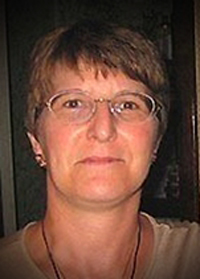Ingrid M. Verhamme, Ph.D.
More Information
Mechanisms important in thrombin localization, inhibitory and substrate serpin recognition, and regulation of serpin-mediated inactivation of fibrin-bound thrombin
Research Information
Our mechanism-based studies involve inactivation of the central clotting protease, thrombin, by the serine proteinase inhibitors (SERPINs) heparin cofactor II (HCII), antithrombin (AT) and plasminogen activator inhibitor-1 (PAI-1). These irreversible inactivation reactions are selectively accelerated by glycosaminoglycans (GAGs) such as heparin, dermatan sulfate, heparan sulfate, and in the case of PAI-1, also by vitronectin. Regulation of these reactions is important in controlling thrombosis and reocclusion.
Thrombin localized on fibrin, and on the cell surface GAGs reacts mainly with HCII and platelet PAI-1 at the injury site, in GAG-accelerated mechanisms different from AT. Subendothelial dermatan sulfate selectively enhances covalent T-HCII formation. Only HCII, in the presence of dermatan sulfate, inhibits fibrin-bound thrombin, by an unknown mechanism, and HCII has been identified as an important inhibitor of arterial thrombosis.
Thrombin possesses two Arg- and Lys-rich exosites, I and II. Exosite I is thought to bind HCII and PAI-1 directly, whereas exosite II - heparin interactions may modulate HCII and PAI-1 turnover as thrombin substrates. These mechanism steps are absent in the thrombin - AT reaction. PAI-1 stabilizes arterial thrombi, but paradoxically, may also promote embolization after atherosclerotic plaque rupture. Selective PAI-1 inhibitory vs. substrate activity toward localized thrombin may be a regulatory mechanism for modulating thrombin activity in arterial clots.
Our lab studies the mechanisms important in thrombin localization, inhibitory and substrate serpin recognition, and the mechanisms by which GAGs act as molecular switches for inhibiting or promoting serpin-mediated inactivation of fibrin-bound thrombin. In collaborative studies, we recently expanded our interests to factor XIa and XIIa interactions with AT and PAI-1, and to serpin-independent anticoagulant and profibrinolytic effects of GAGs, at the level of inhibition of prothrombinase activity, and enhancement of plasminogen activation by tPA and uPA.
Rapid and steady-state kinetics, and equilibrium binding with native and mutant proteins are used to characterize enzyme inactivation, serpin substrate pathway modulation, preferred pathways of productive complex formation, and regulation by fibrinogen and fibrin. These techniques allow quantitation of protein-protein and protein-GAG affinities, and conformational and chemical reaction steps. The combined approaches are aimed at quantitating the HCII and PAI-1 mechanisms of thrombin interaction in the presence of GAGs, and the effect of fibrin on these mechanisms. The goal of these studies is to understand differential HCII and PAI-1 regulation of clot-localized, thrombin-dependent processes in arterial thrombosis and reocclusion.

